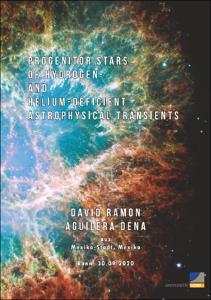Progenitor Stars of Hydrogen- and Helium-Deficient Astrophysical Transients

Progenitor Stars of Hydrogen- and Helium-Deficient Astrophysical Transients

| dc.contributor.advisor | Langer, Norbert | |
| dc.contributor.author | Aguilera Dena, David Ramon | |
| dc.date.accessioned | 2021-01-22T13:32:15Z | |
| dc.date.available | 2021-01-22T13:32:15Z | |
| dc.date.issued | 22.01.2021 | |
| dc.identifier.uri | https://hdl.handle.net/20.500.11811/8890 | |
| dc.description.abstract | Massive stars are among the most influential components of the Universe. They house nuclear reactions that transmute hydrogen and helium, the two elements produced with the highest abundance after the Big Bang, into heavier elements. They enrich their host galaxies with them, and output a significant amount of energy through radiation and stellar winds.
Massive stars end their lives with the collapse of their iron cores, which can lead to energetic transient events such as supernovae (SNe) and gamma-ray bursts (GRBs). These explosions release large amounts of matter and energy into their environment in short time scale. Core-collapse in massive stars is also responsible for the formation of objects such as black holes (BHs) and neutron stars (NSs), often observed as radio and X-ray sources, and more recently as sources of gravitational waves. There are many uncertainties massive stellar evolution. In particular, uncertainties in the effects of rotation, metallicity and mass loss in stellar evolution remain, and permeate our understanding about the formation of energetic transients. In this thesis, we explore certain channels of massive star evolution, and propose them as possible formation channels for the formation of hydrogen- and helium-deficient transients. First, we present evolutionary models of fast-rotating, low metallicity, massive stars, focusing on their late evolution. The combination of low metallicity and fast rotation induces strong mixing in the stellar interior, leading to chemically homogeneous evolving (CHE) stars. As a consequence, no hydrogen and only a small amount of helium are retained at the time of core collapse. We find that neutrino emission during the late phases of evolution causes CHE stars to contract in an accelerated manner, leading to surface spin-up and episodes of strong, rotationally-induced mass loss. Due to their composition and high angular momentum content, we propose these models as progenitors both for hydrogen-free superluminous SNe (SLSNe) and long GRBs. Using similar models, we suggest that the core structure of CHE stars, which varies non-monotonically with initial mass, determines the types of transient they produce at the end of their evolution. We suggest that the non-monotonic variation is the origin of the variety in the observed properties in SLSNe and GRBs. We find that our models can reproduce the observed properties of most SLSNe in the context of the magnetar model. We predict that signatures of mass loss in the last years of evolution should be present in the observations of both SLSNe and long GRBs. Finally, we present evolutionary models of massive helium stars with different metallicities. These systems are representative of the late evolution of progenitors of hydrogen-deficient SNe of Type Ib and Ic. They can be formed by mass loss in very massive stars, or as the result of binary interactions. We characterize the impact of metallicity in their evolution, which alters their stellar winds. We propose a method to explain the observed lower limit in luminosity observed in populations of Wolf-Rayet stars. We simulate helium star populations in different metallicities, and find the properties of the transients they produce. We finally comment on the resulting populations of compact objects. | en |
| dc.language.iso | eng | |
| dc.rights | In Copyright | |
| dc.rights.uri | http://rightsstatements.org/vocab/InC/1.0/ | |
| dc.subject | Astronomie | |
| dc.subject | Astrophysik | |
| dc.subject | Sternphysik | |
| dc.subject | Supernovae | |
| dc.subject | Gammablitz | |
| dc.subject | Astronomy | |
| dc.subject | astrophysics | |
| dc.subject | stellar physics | |
| dc.subject | gamma-ray burst | |
| dc.subject.ddc | 520 Astronomie, Kartografie | |
| dc.title | Progenitor Stars of Hydrogen- and Helium-Deficient Astrophysical Transients | |
| dc.type | Dissertation oder Habilitation | |
| dc.publisher.name | Universitäts- und Landesbibliothek Bonn | |
| dc.publisher.location | Bonn | |
| dc.rights.accessRights | openAccess | |
| dc.identifier.urn | https://nbn-resolving.org/urn:nbn:de:hbz:5-60989 | |
| ulbbn.pubtype | Erstveröffentlichung | |
| ulbbnediss.affiliation.name | Rheinische Friedrich-Wilhelms-Universität Bonn | |
| ulbbnediss.affiliation.location | Bonn | |
| ulbbnediss.thesis.level | Dissertation | |
| ulbbnediss.dissID | 6098 | |
| ulbbnediss.date.accepted | 12.01.2021 | |
| ulbbnediss.institute | Mathematisch-Naturwissenschaftliche Fakultät : Fachgruppe Physik/Astronomie / Argelander-Institut für Astronomie (AIfA) | |
| ulbbnediss.fakultaet | Mathematisch-Naturwissenschaftliche Fakultät | |
| dc.contributor.coReferee | Porciani, Cristiano | |
| ulbbnediss.contributor.orcid | https://orcid.org/0000-0002-3874-2769 |
Dateien zu dieser Ressource
Das Dokument erscheint in:
-
E-Dissertationen (4387)




